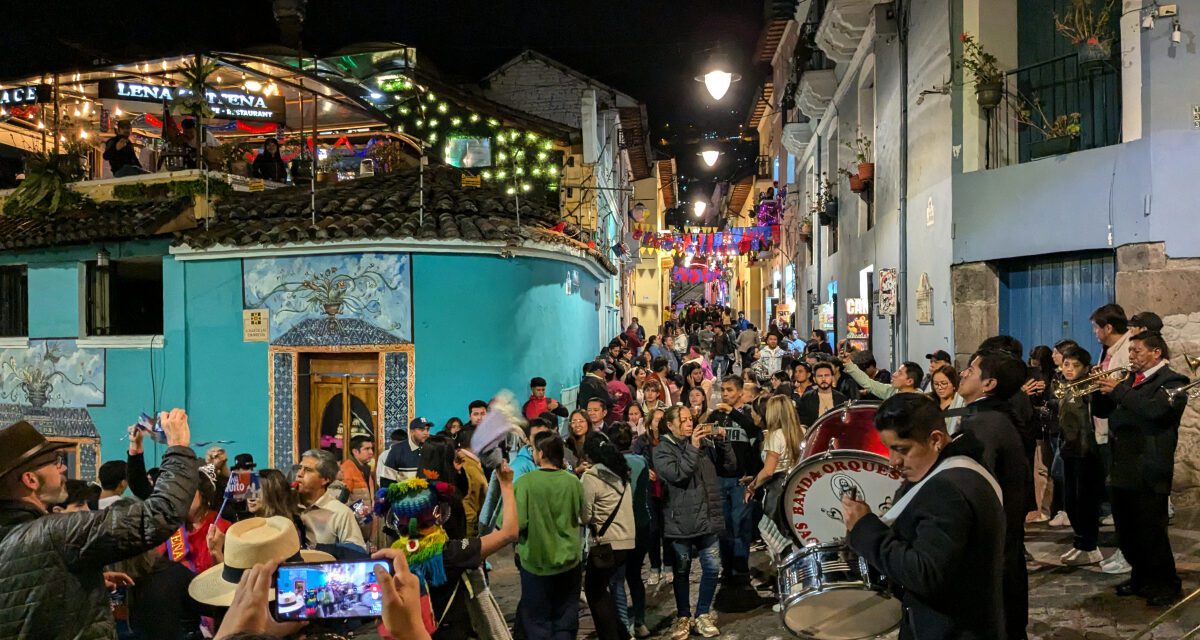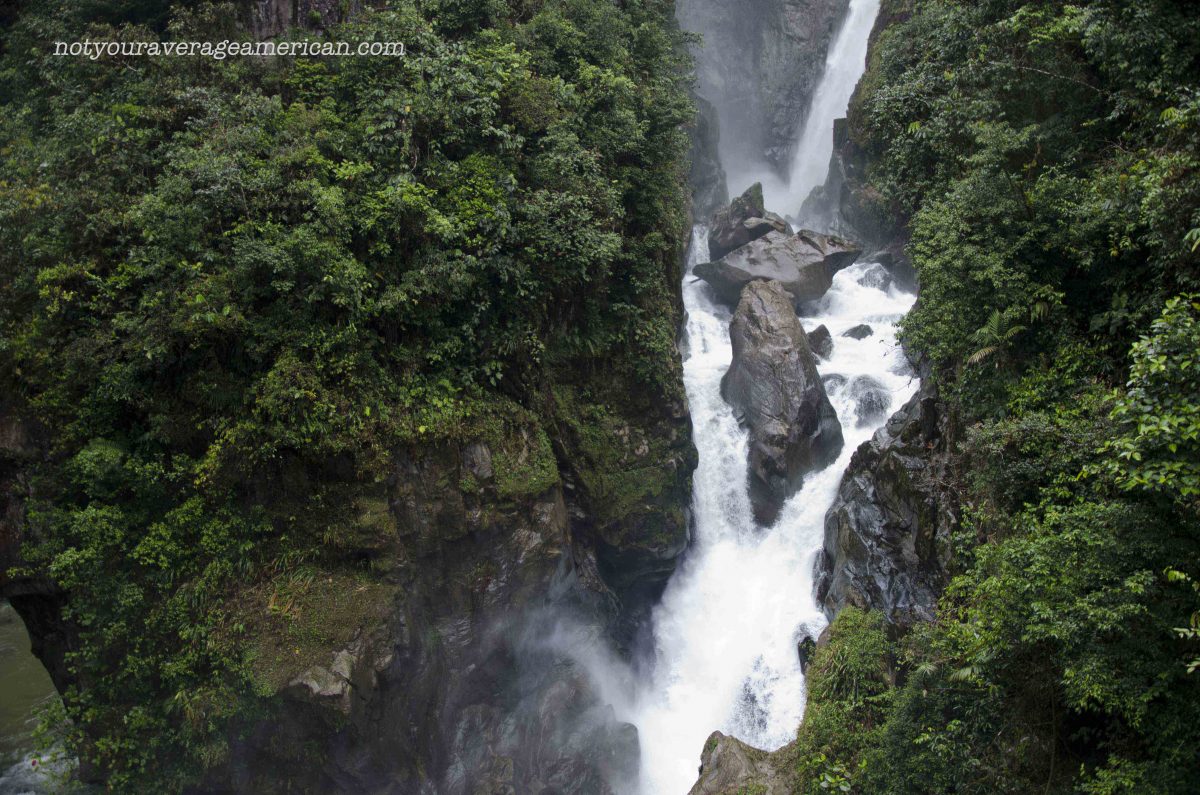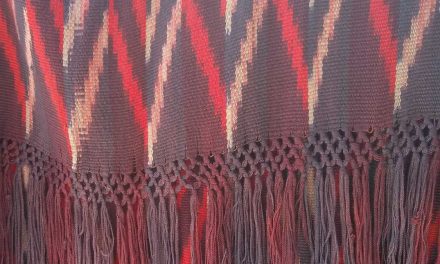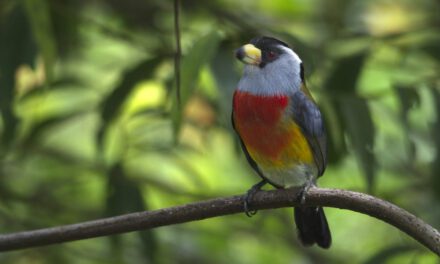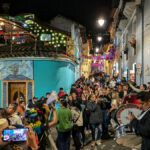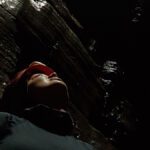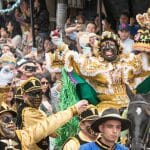The Fiestas de Quito always felt a little hard to enjoy when we lived in Ecuador’s capital. It was a deeply local celebration — the kind where every neighborhood threw its own party, and no one was promoting it to outsiders, let alone tourists.
Still, one year stands out in my memory. Our military enlace invited us, along with a few other attachés and their spouses, to a friendly gathering. That’s when we got our first taste of what makes a Fiestas de Quito celebration truly special. We feasted on heaping plates of hornado, watched a fast-paced card tournament in the back room, danced to the Banda de Pueblo, and drank canelazos.
But most amazing and memorable were incredible homemade fireworks in the back garden — not the neat, organized kind you’d expect on the 4th of July. These were chaotic and thrilling: a crazy bull (a man wearing a metal frame decked out with spinning fireworks and bull horns) and a towering castillo, loaded with wheels of fire that spun wildly in the night. It was part danger, part delight — and completely unforgettable.
In the decade since, it’s become much easier to take part in a local celebration — especially if you’re willing to lean into experiences that seem a little touristy at first, but are, in truth, deeply rooted in Quiteño tradition.
But first, you might be wondering what all the hype is about.

What exactly is the Fiestas de Quito?
Each year, Quito comes alive to celebrate its founding on December 6, 1534. What started as a historical remembrance has become a city-wide, one week celebration that blends tradition and history with folklore and fun.
Generally, the festivities begin the weekend before December 6 and continue until the weekend after… but those dates are very flexible and change from year to year.
Expect neighborhoods to throw their own parties. Bands to play in the streets. Flags and decorations in red and blue — Quito’s colors — to wave from every window. Card tournaments to pop up in cafes, cultural centers, and bars. And at the heart of it all? And, if you’re lucky, a fireworks display or two.
It’s a little chaotic. A little kitschy. And completely wonderful.
But unless you know someone local, it’s hard to experience the real thing. There are traditions that just don’t make sense until someone shows you how it all works. That’s why, last year, when our friend and local guide Jacquie invited us to celebrate with her and another friend, Gustavo, we were thrilled.
Here is what we learned in their experienced hands.
Tips for enjoying Fiestas de Quito like a Local

Play Cuarenta, the ultimate Quiteño card game
Jacquie and Gustavo took the time to teach us how to play Cuarenta, a very Ecuadorian card game that comes with local rules particular to Quito or to Cuenca or other places where you might learn the game. You can read the rules or even play a game or two online in preparation for Fiestas de Quito.
But to prepare your team in the proper manner, you should play a few rounds with a Quiteño, if only to learn the particular slang that goes along with the game. Cuarenta tournaments crop up in many locations and we saw them advertised at community centers and more.
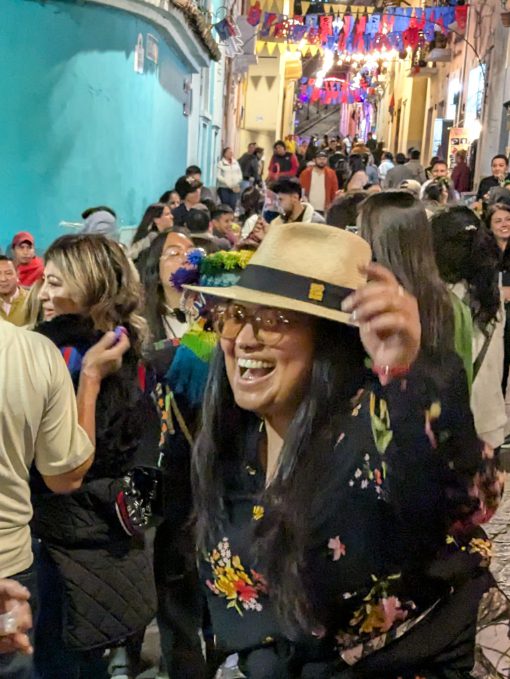
Dance To a Banda del Pueblo
A Banda del Pueblo is more than just a party band — it’s a deeply rooted tradition in Ecuadorian culture, especially during major festivities like the Fiestas de Quito. These brass and percussion ensembles have been part of community celebrations for centuries, playing everything from traditional pasillos and albazos to modern cumbias that get everyone dancing.
In Quito, this isn’t just a weekend hobby — there are even schools dedicated to teaching the music and performance style of the Banda del Pueblo, passing the art form from one generation to the next.
Their energy is contagious. You’ll hear them before you see them: trumpets blaring and drums resounding. When they show up, the party starts — and there’s no standing still!

Celebrate on a Chiva
If you’re anywhere near Parque La Carolina during the Fiestas de Quito — especially on nights and weekends — you’ll see Chivas lined up and ready to roll. These open-air party buses are a classic part of the festivities.
Expect cheap alcohol, very loud music, and zero personal space — which makes it easy to become best friends with the person dancing next to you. These rides can get wild, fun, and just a little chaotic. A word of caution: Chivas are notorious for being packed, so keep an eye on your belongings and watch out for pickpockets.
If you’re up for the ride, it’s one of the most unforgettable ways to celebrate like a Quiteño.
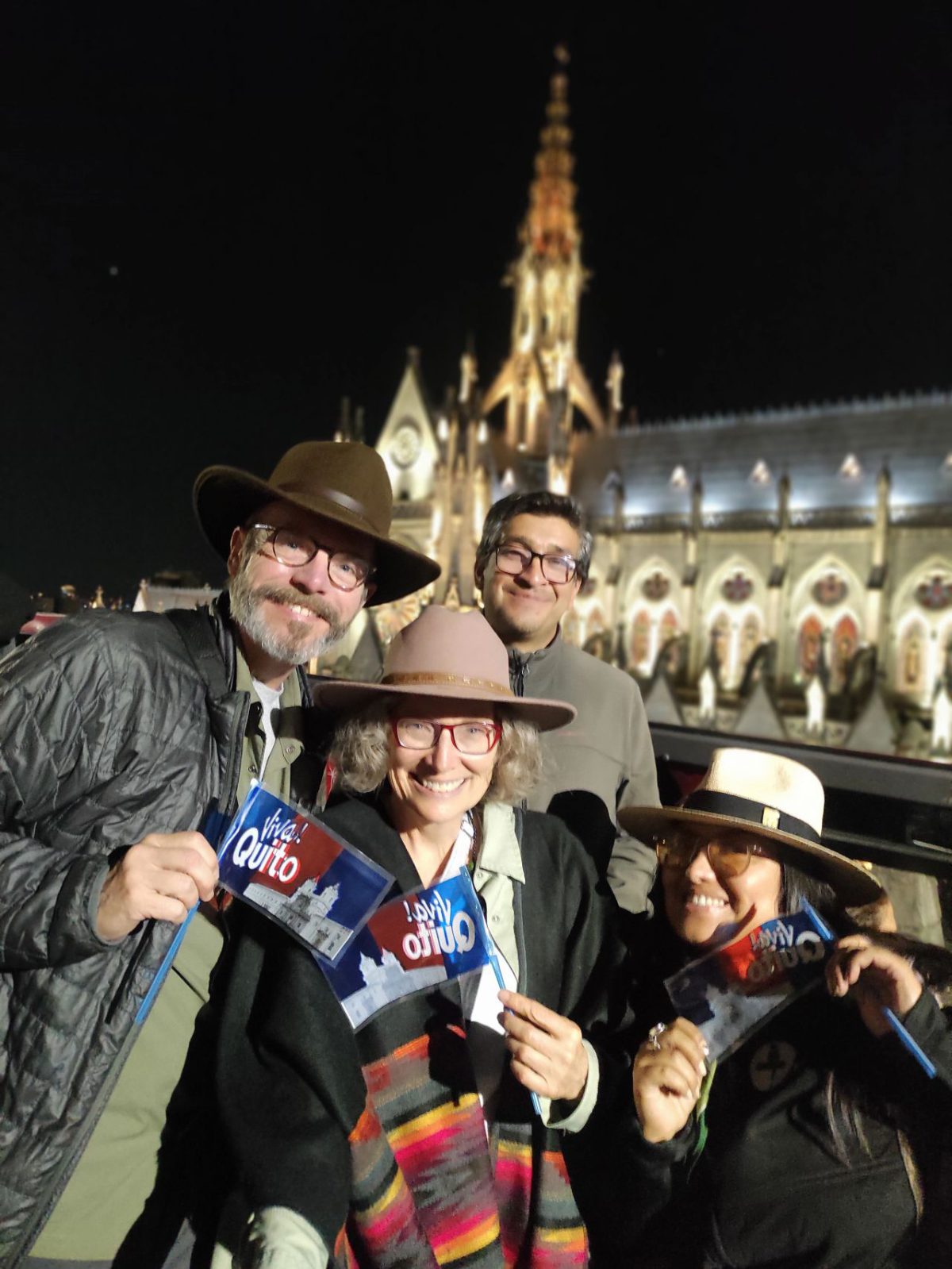
Party on the Quito Tour Bus
If the idea of a packed, rowdy Chiva doesn’t sound like your kind of fun, or if you’re traveling with family or just want a more relaxed vibe, or you are just risk averse like ourselves, the Quito Tour Bus offers a fantastic alternative.
Still festive, still filled with Quiteños, this double-decker bus offers a night time tour of city highlights, a banda de pueblo, and dancing in the streets in the La Ronda neighborhood. It’s a great way to take part in the excitement without needing to elbow your way through a crowd or worry about spilled aguardiente on your shoes.
It’s also the only bus where you might get elected Reina — a lighthearted nod to one of Quito’s most beloved Fiestas traditions. (Yes, I was elected Reina. No, I didn’t volunteer. Yes, Jacquie is entirely to blame!) Also, while not the only tourists, we were the only native English speakers which is why I had to give a speech in Spanish. Oh my!
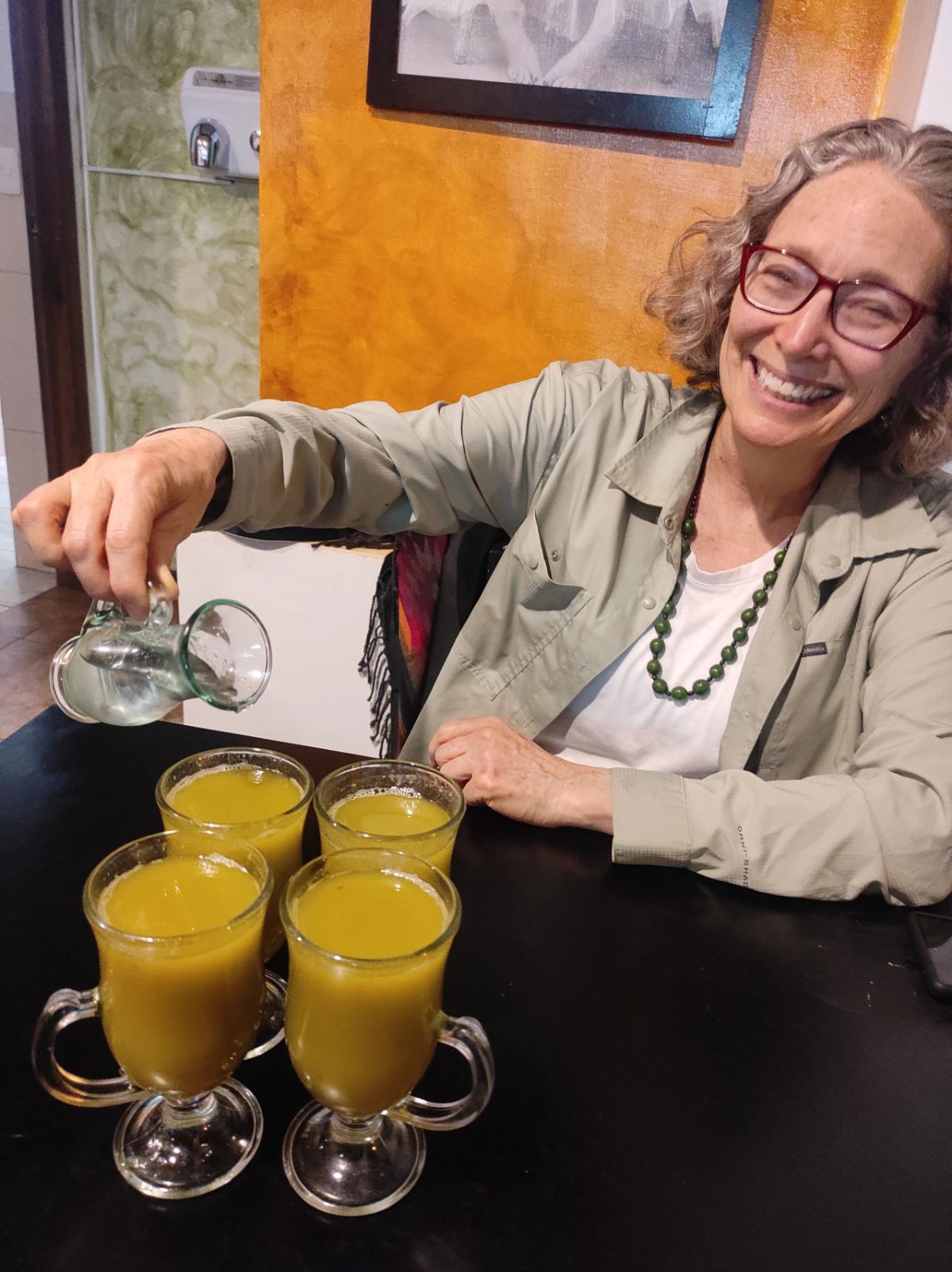
Sip a Canelazo
Rather than take the Quito Tour Bus back to Parque Carolina, we ditched their party after dancing in La Ronda. Instead, we headed to a local bar to eat empanadas de morocho and drink canelazos. There are several locations to choose from. We took the Quito Metro back to Parque Carolina (check the hours but they generally run until midnight).
What is a Canelazo you wonder?
Canelazo is a sweet, fruity hot toddy that’s a beloved Quiteño tradition, especially on chilly nights. Made from naranjilla juice (a tart, citrusy Andean fruit) simmered with cinnamon, sugar, and cloves, it’s the kind of drink that warms your hands and your spirit.
Traditionally, it’s spiked with aguardiente, a strong sugarcane liquor, but many places serve the alcohol on the side. Either way, it’s a must-have during the festivities. You’ll find it in cafes, street stands, and especially at neighborhood parties, where it’s often paired with empanadas and a live banda.

Gawk at the Vaca Loca
Watching a vaca loca in action is something else entirely. A man — sometimes intoxicated — straps on a metal frame rigged with spinning, sparking fireworks and charges around the grounds. It’s chaotic, slightly terrifying, and completely mesmerizing. You can’t help but marvel at the nerve it takes to wear what’s essentially a moving, exploding firework display.
It’s not always easy to find an advertised vaca loca or castillo — these aren’t usually posted online or promoted in tourist guides. But if you’re lucky, you might stumble across one at a neighborhood gathering or a civic club event during the Fiestas. In our experience, you best chances might be outside of the main city in smaller towns like Calderon and El Quinche.
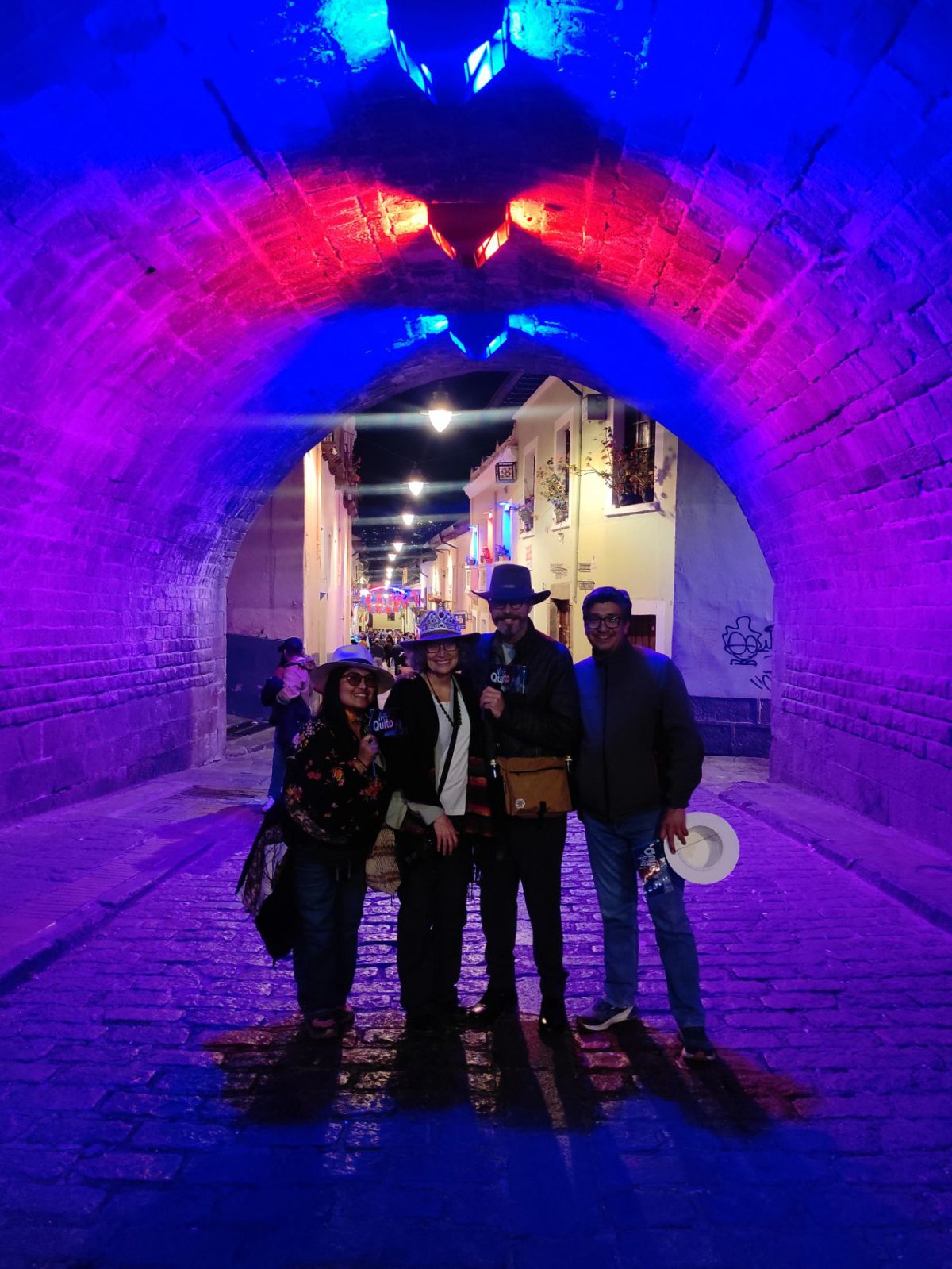
Jacquie Said It Best…
In her own LinkedIn post, Jacquie summed up the celebration perfectly:
“It was a joy to host my friends Angie and Scott during the Fiestas de Quito. I so appreciated their enthusiasm and spirit as they embraced all that our city has to offer — and then some. For anyone who hasn’t experienced it, take this as your personal invitation!”
While it’s absolutely possible to plan your own Fiestas de Quito experience — hopping on the Quito Tour Bus and spending your evenings in La Ronda, maybe even playing in a cuarenta tournament — nothing compares to the feeling of being truly connected to the celebration. That kind of experience is hard to come by without the insight and warmth of a local guide.
¡Qué viva Quito! ¡Qué viva el turismo transformacional!

